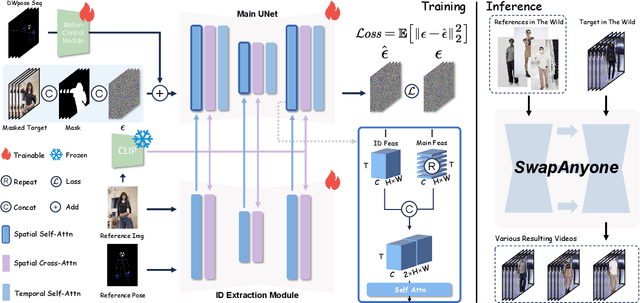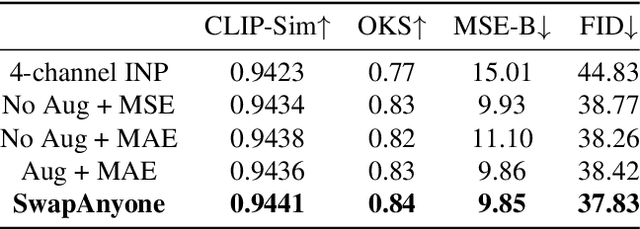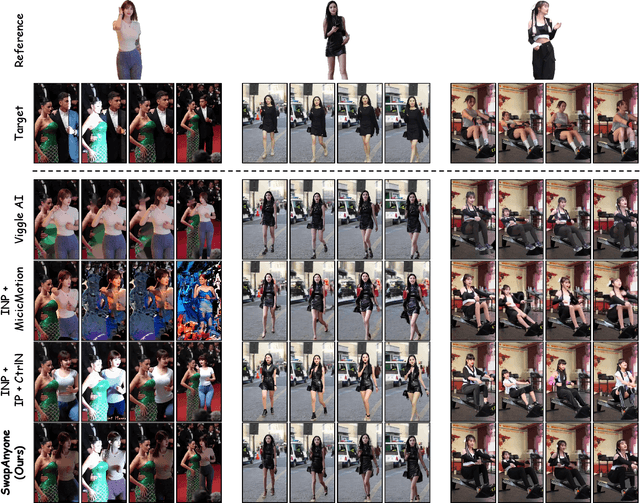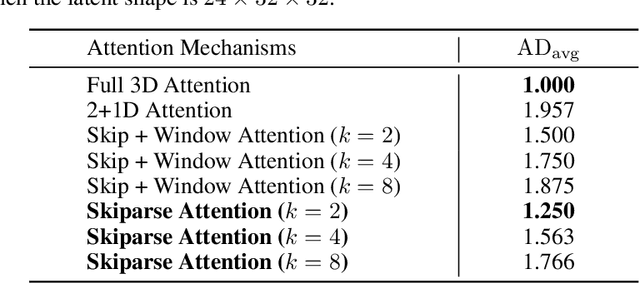Bin Lin
Can Understanding and Generation Truly Benefit Together -- or Just Coexist?
Sep 11, 2025Abstract:In this paper, we introduce an insightful paradigm through the Auto-Encoder lens-understanding as the encoder (I2T) that compresses images into text, and generation as the decoder (T2I) that reconstructs images from that text. Using reconstruction fidelity as the unified training objective, we enforce the coherent bidirectional information flow between the understanding and generation processes, bringing mutual gains. To implement this, we propose UAE, a novel framework for unified multimodal learning. We begin by pre-training the decoder with large-scale long-context image captions to capture fine-grained semantic and complex spatial relationships. We then propose Unified-GRPO via reinforcement learning (RL), which covers three stages: (1) A cold-start phase to gently initialize both encoder and decoder with a semantic reconstruction loss; (2) Generation for Understanding, where the encoder is trained to generate informative captions that maximize the decoder's reconstruction quality, enhancing its visual understanding; (3) Understanding for Generation, where the decoder is refined to reconstruct from these captions, forcing it to leverage every detail and improving its long-context instruction following and generation fidelity. For evaluation, we introduce Unified-Bench, the first benchmark tailored to assess the degree of unification of the UMMs. A surprising "aha moment" arises within the multimodal learning domain: as RL progresses, the encoder autonomously produces more descriptive captions, while the decoder simultaneously demonstrates a profound ability to understand these intricate descriptions, resulting in reconstructions of striking fidelity.
OpenS2V-Nexus: A Detailed Benchmark and Million-Scale Dataset for Subject-to-Video Generation
May 28, 2025Abstract:Subject-to-Video (S2V) generation aims to create videos that faithfully incorporate reference content, providing enhanced flexibility in the production of videos. To establish the infrastructure for S2V generation, we propose OpenS2V-Nexus, consisting of (i) OpenS2V-Eval, a fine-grained benchmark, and (ii) OpenS2V-5M, a million-scale dataset. In contrast to existing S2V benchmarks inherited from VBench that focus on global and coarse-grained assessment of generated videos, OpenS2V-Eval focuses on the model's ability to generate subject-consistent videos with natural subject appearance and identity fidelity. For these purposes, OpenS2V-Eval introduces 180 prompts from seven major categories of S2V, which incorporate both real and synthetic test data. Furthermore, to accurately align human preferences with S2V benchmarks, we propose three automatic metrics, NexusScore, NaturalScore and GmeScore, to separately quantify subject consistency, naturalness, and text relevance in generated videos. Building on this, we conduct a comprehensive evaluation of 16 representative S2V models, highlighting their strengths and weaknesses across different content. Moreover, we create the first open-source large-scale S2V generation dataset OpenS2V-5M, which consists of five million high-quality 720P subject-text-video triples. Specifically, we ensure subject-information diversity in our dataset by (1) segmenting subjects and building pairing information via cross-video associations and (2) prompting GPT-Image-1 on raw frames to synthesize multi-view representations. Through OpenS2V-Nexus, we deliver a robust infrastructure to accelerate future S2V generation research.
ImgEdit: A Unified Image Editing Dataset and Benchmark
May 26, 2025Abstract:Recent advancements in generative models have enabled high-fidelity text-to-image generation. However, open-source image-editing models still lag behind their proprietary counterparts, primarily due to limited high-quality data and insufficient benchmarks. To overcome these limitations, we introduce ImgEdit, a large-scale, high-quality image-editing dataset comprising 1.2 million carefully curated edit pairs, which contain both novel and complex single-turn edits, as well as challenging multi-turn tasks. To ensure the data quality, we employ a multi-stage pipeline that integrates a cutting-edge vision-language model, a detection model, a segmentation model, alongside task-specific in-painting procedures and strict post-processing. ImgEdit surpasses existing datasets in both task novelty and data quality. Using ImgEdit, we train ImgEdit-E1, an editing model using Vision Language Model to process the reference image and editing prompt, which outperforms existing open-source models on multiple tasks, highlighting the value of ImgEdit and model design. For comprehensive evaluation, we introduce ImgEdit-Bench, a benchmark designed to evaluate image editing performance in terms of instruction adherence, editing quality, and detail preservation. It includes a basic testsuite, a challenging single-turn suite, and a dedicated multi-turn suite. We evaluate both open-source and proprietary models, as well as ImgEdit-E1, providing deep analysis and actionable insights into the current behavior of image-editing models. The source data are publicly available on https://github.com/PKU-YuanGroup/ImgEdit.
SwapAnyone: Consistent and Realistic Video Synthesis for Swapping Any Person into Any Video
Mar 12, 2025



Abstract:Video body-swapping aims to replace the body in an existing video with a new body from arbitrary sources, which has garnered more attention in recent years. Existing methods treat video body-swapping as a composite of multiple tasks instead of an independent task and typically rely on various models to achieve video body-swapping sequentially. However, these methods fail to achieve end-to-end optimization for the video body-swapping which causes issues such as variations in luminance among frames, disorganized occlusion relationships, and the noticeable separation between bodies and background. In this work, we define video body-swapping as an independent task and propose three critical consistencies: identity consistency, motion consistency, and environment consistency. We introduce an end-to-end model named SwapAnyone, treating video body-swapping as a video inpainting task with reference fidelity and motion control. To improve the ability to maintain environmental harmony, particularly luminance harmony in the resulting video, we introduce a novel EnvHarmony strategy for training our model progressively. Additionally, we provide a dataset named HumanAction-32K covering various videos about human actions. Extensive experiments demonstrate that our method achieves State-Of-The-Art (SOTA) performance among open-source methods while approaching or surpassing closed-source models across multiple dimensions. All code, model weights, and the HumanAction-32K dataset will be open-sourced at https://github.com/PKU-YuanGroup/SwapAnyone.
WISE: A World Knowledge-Informed Semantic Evaluation for Text-to-Image Generation
Mar 10, 2025Abstract:Text-to-Image (T2I) models are capable of generating high-quality artistic creations and visual content. However, existing research and evaluation standards predominantly focus on image realism and shallow text-image alignment, lacking a comprehensive assessment of complex semantic understanding and world knowledge integration in text to image generation. To address this challenge, we propose $\textbf{WISE}$, the first benchmark specifically designed for $\textbf{W}$orld Knowledge-$\textbf{I}$nformed $\textbf{S}$emantic $\textbf{E}$valuation. WISE moves beyond simple word-pixel mapping by challenging models with 1000 meticulously crafted prompts across 25 sub-domains in cultural common sense, spatio-temporal reasoning, and natural science. To overcome the limitations of traditional CLIP metric, we introduce $\textbf{WiScore}$, a novel quantitative metric for assessing knowledge-image alignment. Through comprehensive testing of 20 models (10 dedicated T2I models and 10 unified multimodal models) using 1,000 structured prompts spanning 25 subdomains, our findings reveal significant limitations in their ability to effectively integrate and apply world knowledge during image generation, highlighting critical pathways for enhancing knowledge incorporation and application in next-generation T2I models. Code and data are available at https://github.com/PKU-YuanGroup/WISE.
Next Patch Prediction for Autoregressive Visual Generation
Dec 19, 2024Abstract:Autoregressive models, built based on the Next Token Prediction (NTP) paradigm, show great potential in developing a unified framework that integrates both language and vision tasks. In this work, we rethink the NTP for autoregressive image generation and propose a novel Next Patch Prediction (NPP) paradigm. Our key idea is to group and aggregate image tokens into patch tokens containing high information density. With patch tokens as a shorter input sequence, the autoregressive model is trained to predict the next patch, thereby significantly reducing the computational cost. We further propose a multi-scale coarse-to-fine patch grouping strategy that exploits the natural hierarchical property of image data. Experiments on a diverse range of models (100M-1.4B parameters) demonstrate that the next patch prediction paradigm could reduce the training cost to around 0.6 times while improving image generation quality by up to 1.0 FID score on the ImageNet benchmark. We highlight that our method retains the original autoregressive model architecture without introducing additional trainable parameters or specifically designing a custom image tokenizer, thus ensuring flexibility and seamless adaptation to various autoregressive models for visual generation.
DreamDance: Animating Human Images by Enriching 3D Geometry Cues from 2D Poses
Nov 30, 2024Abstract:In this work, we present DreamDance, a novel method for animating human images using only skeleton pose sequences as conditional inputs. Existing approaches struggle with generating coherent, high-quality content in an efficient and user-friendly manner. Concretely, baseline methods relying on only 2D pose guidance lack the cues of 3D information, leading to suboptimal results, while methods using 3D representation as guidance achieve higher quality but involve a cumbersome and time-intensive process. To address these limitations, DreamDance enriches 3D geometry cues from 2D poses by introducing an efficient diffusion model, enabling high-quality human image animation with various guidance. Our key insight is that human images naturally exhibit multiple levels of correlation, progressing from coarse skeleton poses to fine-grained geometry cues, and further from these geometry cues to explicit appearance details. Capturing such correlations could enrich the guidance signals, facilitating intra-frame coherency and inter-frame consistency. Specifically, we construct the TikTok-Dance5K dataset, comprising 5K high-quality dance videos with detailed frame annotations, including human pose, depth, and normal maps. Next, we introduce a Mutually Aligned Geometry Diffusion Model to generate fine-grained depth and normal maps for enriched guidance. Finally, a Cross-domain Controller incorporates multi-level guidance to animate human images effectively with a video diffusion model. Extensive experiments demonstrate that our method achieves state-of-the-art performance in animating human images.
Open-Sora Plan: Open-Source Large Video Generation Model
Nov 28, 2024



Abstract:We introduce Open-Sora Plan, an open-source project that aims to contribute a large generation model for generating desired high-resolution videos with long durations based on various user inputs. Our project comprises multiple components for the entire video generation process, including a Wavelet-Flow Variational Autoencoder, a Joint Image-Video Skiparse Denoiser, and various condition controllers. Moreover, many assistant strategies for efficient training and inference are designed, and a multi-dimensional data curation pipeline is proposed for obtaining desired high-quality data. Benefiting from efficient thoughts, our Open-Sora Plan achieves impressive video generation results in both qualitative and quantitative evaluations. We hope our careful design and practical experience can inspire the video generation research community. All our codes and model weights are publicly available at \url{https://github.com/PKU-YuanGroup/Open-Sora-Plan}.
WF-VAE: Enhancing Video VAE by Wavelet-Driven Energy Flow for Latent Video Diffusion Model
Nov 26, 2024Abstract:Video Variational Autoencoder (VAE) encodes videos into a low-dimensional latent space, becoming a key component of most Latent Video Diffusion Models (LVDMs) to reduce model training costs. However, as the resolution and duration of generated videos increase, the encoding cost of Video VAEs becomes a limiting bottleneck in training LVDMs. Moreover, the block-wise inference method adopted by most LVDMs can lead to discontinuities of latent space when processing long-duration videos. The key to addressing the computational bottleneck lies in decomposing videos into distinct components and efficiently encoding the critical information. Wavelet transform can decompose videos into multiple frequency-domain components and improve the efficiency significantly, we thus propose Wavelet Flow VAE (WF-VAE), an autoencoder that leverages multi-level wavelet transform to facilitate low-frequency energy flow into latent representation. Furthermore, we introduce a method called Causal Cache, which maintains the integrity of latent space during block-wise inference. Compared to state-of-the-art video VAEs, WF-VAE demonstrates superior performance in both PSNR and LPIPS metrics, achieving 2x higher throughput and 4x lower memory consumption while maintaining competitive reconstruction quality. Our code and models are available at https://github.com/PKU-YuanGroup/WF-VAE.
Takin-ADA: Emotion Controllable Audio-Driven Animation with Canonical and Landmark Loss Optimization
Oct 18, 2024Abstract:Existing audio-driven facial animation methods face critical challenges, including expression leakage, ineffective subtle expression transfer, and imprecise audio-driven synchronization. We discovered that these issues stem from limitations in motion representation and the lack of fine-grained control over facial expressions. To address these problems, we present Takin-ADA, a novel two-stage approach for real-time audio-driven portrait animation. In the first stage, we introduce a specialized loss function that enhances subtle expression transfer while reducing unwanted expression leakage. The second stage utilizes an advanced audio processing technique to improve lip-sync accuracy. Our method not only generates precise lip movements but also allows flexible control over facial expressions and head motions. Takin-ADA achieves high-resolution (512x512) facial animations at up to 42 FPS on an RTX 4090 GPU, outperforming existing commercial solutions. Extensive experiments demonstrate that our model significantly surpasses previous methods in video quality, facial dynamics realism, and natural head movements, setting a new benchmark in the field of audio-driven facial animation.
 Add to Chrome
Add to Chrome Add to Firefox
Add to Firefox Add to Edge
Add to Edge